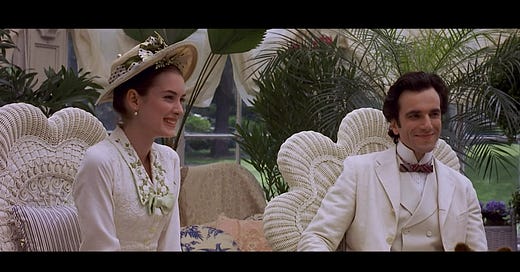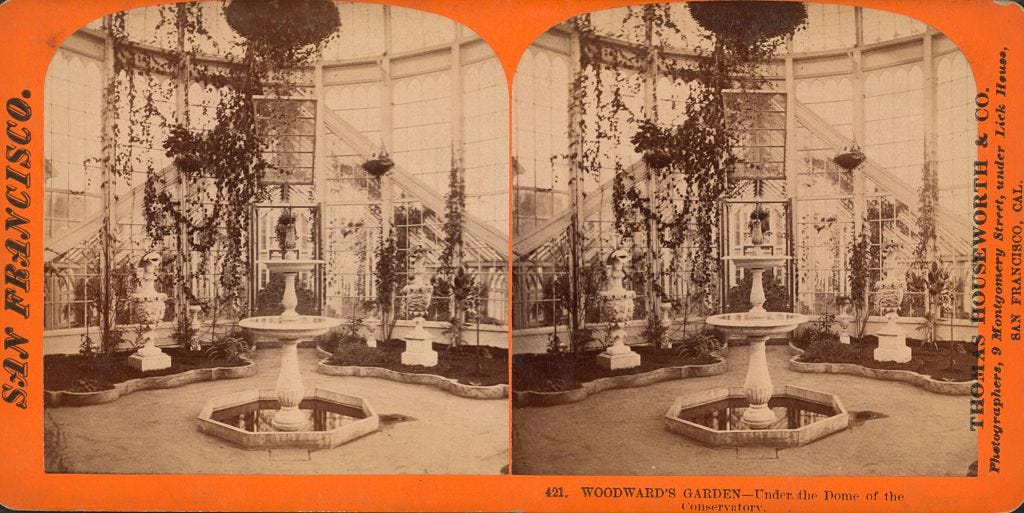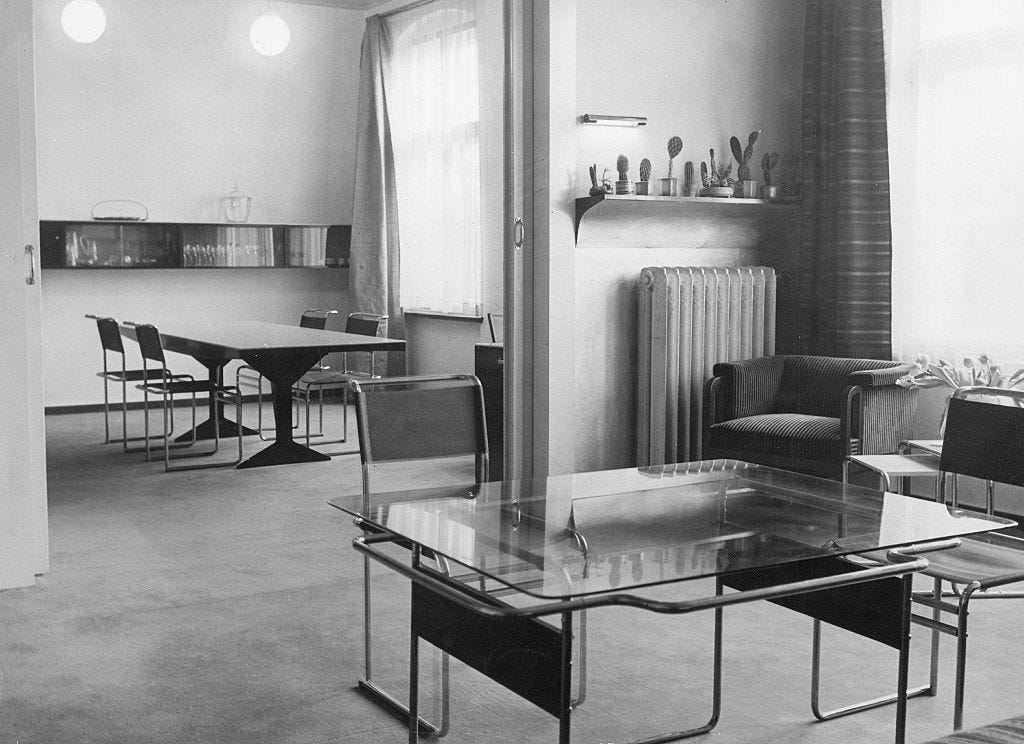Do you find yourself opening this newsletter every week? Do you value the labor that goes into it? Have you become a paid subscriber? Think about it!
Many of the people who read this newsletter the most are people who haven’t gone over to paid. I’m constantly saying I’m going to pay for things and take weeks to actually do it, so I get it. But maybe today is your day.

Earlier this month, I was rewatching Scorsese’s The Age of Innocence in an attempt to wash the flatness of The Gilded Age out of my brain, and I noticed something I’d never, in nearly a dozen viewings, taken note of before: the houseplants. I had spent the day browsing old advertisements and renderings of Victorian homes, and the echoes in the set design were everywhere. Palms in the series of drawing rooms leading to a ballroom, ferns framing a fireplace, and, a somewhat pivotal scene featuring May, Archer, and May’s grandmother, set in the conservatory in her Newport home.
The minutiae of social machinations infuse Wharton’s prose and, by extension, the sets and costuming of the film adaptation — itself the work of master production designer Dante Ferretti. The presence of these plants, in glorious, sometimes almost swallowing state, signaled a sort of belonging the same way that attending the opera, or a concerto, would. Indoor plants, then, as a very particular form of aspirational culture.
Today, an estimated three fourths of adults have a houseplant in their home, and household spending on houseplants has climbed a stunning fifty percent since 2016. Part of the popularity can be traced to pandemic isolation — we’re stuck in our homes; what can we do with them? — but the new wave of indoor plant obsession began well before 2020. As Catherine Horwood points out in her book Potted History, propagation has become more sophisticated, which means that plants themselves became cheaper — an orchid from Trader Joe’s, for example, costs about a forth of what it would’ve back in the 1970s. The popularity of cannabis cultivation means that grow lights are accessible and affordable. And houseplants, well, they look good on Instagram.
But lots of things are cheap and look good on Instagram, and I don’t own 34 of them and constantly yearn for more. Houseplants occupy a curious intersection of home and design and history: they are hobbies, and testimonies of skill (or lack thereof), and components of interior design. At the same time, they’re also artifacts of colonization and the controlling impulses that accompanied it, and quiet, nostalgic attempts to regain a steadily dissipating relationship with the natural world.
A house plant is never “just” a house plant, the same way a couch is never just a couch or a movie is just a movie. Houseplants said something about the people who cultivated them in the early 1600s, which was different than what it said about something in the 1860s, or the 1960s, or today. To try and understand what, exactly, our house plants mean today — why we collect and display them the way we do, what they communicate, and how that might be in flux — we have to understand, even if just briefly, what they’ve meant before.
Before the 1600s, there was little need to cultivate plants indoors, because all of the plants available were ones that grew, well, outdoors: native plants, well-adapted to the particulars of local climate. Some plants were grown indoors for year-round herbs and medicinal treatments, but their use was ultimately practical. That began to change with the ongoing colonization of the “Far East,” the so-called “New World,” and Africa, which made it possible for plants to be transplanted back (using a particular sort of mini-greenhouse box) to Europe; citrus trees, palms, and other “exoticks” became desirable forms of decoration for trade, categorization, collection, and sale.

The impulse to move, rename, and cultivate these plants was part of the larger colonial project to “civilize” — e.g., exploit and control — lands that various crowns had claimed as their own. In Nature Inside: Plants and Flowers in the Modern Interior, design historian Penny Sparke argues that the colonial impulse to control and “tame” — to “subordinate nature to reason” — shadows so much of interior plant cultivation. You take a plant that has learned to live one way (quite well!) and take it to a generally hostile climate, rename it, keep it in a small area, and attempt to keep it alive. I think some gardeners think of this as “a challenge” — the sort that, with enough care and money and time and discipline, you can master. To grow an “exotick,” as these plants were often called, was a way to evidence mastery of the New World — even from the sitting room of your home in London.
Over the course of the 17th century, citrus fruit became more readily available , and the trees fell out of fashion. But gardening indoors did not. In 1666, what became known as the Great Fire swept through London, destroying more than 13,000 homes. In its wake, regulators developed new guidelines to protect against future fires, including a law, passed in 1708, requiring all windows to be set back at least four inches into the brickwork. Enter: the standardized windowsill. Technology from Holland made much larger windows possible, and terraces became a regular feature in new homes. Ample room, in other words, for a whole lot of plants.
Over the next century, ornamental plants became a fixture in the middle-class home — mignotte plants, used to mask scents within and outside of the home, on specially made pans; forced crocuses in clever little pots; umbrella plants as close to the fireplace as possible, and terrariums of various sizes. In poorer neighborhoods, scarlet geraniums were a regular feature of the windowsill; in richer ones, conservatories (and green houses) like the ones from Age of Innocence became increasingly popular. (Wharton describes Buford’s conservatory as a place where “camellias and tree ferns arched their costly foliage over seats of black and gold bamboo.”) Sometimes these spaces were maintained by servants and the same gardeners who attended to outdoor garden spaces, but unlike outdoor garden design — which had historically been considered the provenance of men — interior plant design was “women’s work.”
Conservatories were often adjoined to women’s sitting/receiving rooms, but the plants themselves were conceived of as a form of craftwork. As Sparke, the interior design historian, points out, “shell-work, hair-work, leather-work, work with moss and pine cones, Berlin wool-work, crochet and embroidery, as well as arranging plants and flowers, making floral wreaths, bouquets and tables decorations, and pressing and mounting ferns and flowers grew apace in this period, supporting the never-ending quest for domestic beauty and the social status that beauty was seen to mark.”
A flourishing set of indoor plants, in other words, were yet another means of evidencing one’s proper Victorian womanhood. Horwood writes that by the mid-19th century, “British homes were in the grip of a horticultural hysteria. Whether it was orchid fever, camelia crazes or fuchsia fantasies, middle-class families now were seized by a green-fingered fervor in their attempts to out-plant their next-door neighbor.” The yearning for lush experiences of nature in the home was also an extension of the Romanticism typified so much art of the era — a sort of “aide-memoire,” as Sparke puts it, for an idealized pre-Industrial past. More and more people were moving from the countryside to the city, with smaller and smaller areas of outdoor space at their disposal. So they brought the green space indoors, or onto the balcony — and they went to the park.
Conservatories and “glass houses” began popping up in the public gardens of major cities: in Paris, the “Serre Mexicaine” at the Jardin des Plantes (1838); in London, the Palm House at Kew Gardens opened in 1848; in 1851, Price Albert commissioned a massive “Crystal Palace,” sprawling most of Hyde Park, to house the Great International Exhibition; President James Buchanan began construction on a small conservatory at the White House in 1857, which was rebuilt and enlarged after a fire (only to be dismantled in 1902 and replaced with The West Wing).

Copenhagen’s 3000 square-meter glasshouse complex opened in 1874, followed by San Francisco’s Conservatory of Flowers (1878), the St. Louis Linnean House (1882), the later-demolished Central Park Conservatory (late 1880s), Chicago’s Lincoln Park Conservatory (1895, replacing a set of greenhouses from the 1870s), and dozens more across Europe and North America.
These spaces might have been inspirational and aspirational, in a sense, for those who visited them. But they were also subtle demonstrations of empiric might: a means to display the more seemly components of conquest and containment to the public at large. Conservatories and botanic gardens were exquisite distractions from the actual wreckage and suffering of empire (look here, not there) just as the cultivation of interior beauty (concentrate here, not there) distracted women of the time from their own generalized subjugation — and, of course, the enduring hierarchies that kept one class of woman designing her sitting room and another class of women dusting it.
It makes sense, then, that during the first half of the 20th century — and gradual destruction or loosening of various social hierarchies — that indoor plants fell out of fashion. Empires either ceased to expand or began to retract; “The New Woman” entered in the public sphere in ever-increasing numbers; the Great War and the following Great Depression destabilized the upper echelons of the class hierarchy. The ruptures of society and class led design to Modernism, and its corresponding rejection of the stuffy emotionalism of Victorianism. As Sparke explains, these modernist designers were “driven by a utopian desire to start from scratch, to modernize and democratize their buildings, and to eliminate clutter — which, in their minds, was synonymous with the stuffy world of their childhoods, upward aspiration, conspicuous display, excessive materialism and femininity — they sought to create rationally conceived, minimally furnished inside spaces that were extension of their architectural frames and, ideally, indistinguishable from them.”
Which isn’t to say that plants disappeared. Modernist architecture famously works to blur the divide between exterior and interior spaces, and Modernist designs often included spaces within the home specifically designed for plants: concrete planters, for example, in and outside the home. But unlike the cacophony of plants in Victorian households, plants were deployed sparingly within Modernism: they were the presence that made the blank space sing. Looking at the historical photos of these modernist spaces in Nature Inside is like looking at the plant version of the cool girl with perfect, seemingly make-up-less skin and a “messy” bun of hair that’s just had a $400 balayage treatment.
In a photo of the Grace Miller house, designed in 1937, a single, exquisitely pruned manzanita hangs out casually in the corner of the room; in photographs of the Eames House in Los Angeles, designed by Charles and Ray Eames in 1949, a gorgeous monstera (often known as a “Swiss-cheese plant”) gives off the feel of a much-valued sculpture. (Sorry, there are apparently no photos online, but it sure looks gorgeous in the Nature Inside). In Ludwig Miles van der Rohe’s Villa Tugendhat, built in 1930, a potted maple casually unites the convergence of a complex set of planes, angles, stairs, and surface materials.
These plants are doing the same sort of multi-layered communicative labor as those in Victorian homes. They just seem more casual — even as they’re far more meticulously controlled, both in their placement and their function.

Here, you can see two overarching (and occasionally overlapping) stereotypes of indoor plant design and maintenance emerge. The first is the PLANT PERSON, in which a home overflows with plants overseen by an obsessive, feminized owner (regardless of actual gender). This stereotype frames cultivation as a domestic craft, and embraces an aesthetic that’s often understood as cluttered, irrational, ostentatious, or crass.
In these scenarios, plants are always in danger of becoming overgrown, or multiplying with great rapidity, or being over-watered — a symptom of the overindulgent parent. There are always cuttings propagating in slowly-browning glasses of water. There’s anthropomorphizing, and human names for individual species, and emotional attachment. It’s the Victorian attempt at domestic beauty gone horribly sour.
The opposite stereotype is that of the PLANT DESIGNER, who sees plants as a rational solution to architectural quandraries. In this framework, plants are deployed as a form of high art — sparingly used, meticulously controlled, never unruly, a means of masculinizing and systematizing the domestic space.
See: bonsai, single succulents, air plants, expensive house “trees” in expensive containers, Scandinavian design watering cans, water-reminder apps, propagating in perfectly arranged trays if at all. This realm is the provenance of men, who view the plant(s) as “design,” not “decor,” and perfectionist Pinterest-moms. The plants don’t define them, or their worth. They define the worth of the plant.
Are those stereotypes fair? No! Do they nonetheless undergird how we think of plants in the home in this moment? Yes! In the next edition, we’ll look at how houseplants got cool again in the post-war period, ended up as the cover story of New York Magazine three times over three years in the 1970s — and how, forty years later, and to the great surprise of pretty much everyone, houseplants became “the only thing millennials didn’t kill.”
If you’re not yet subscribed, click here to make sure it arrives in your inbox next week.
Thank you for reading! If you’re looking for this week’s Things I Read and Loved, including the Just Trust Me, you know where to find it:
Subscribing is also how participate in the heart of the Culture Study Community. There’s the weirdly fun/interesting/generative weekly discussion threads plus the Culture Study Discord, where there’s dedicated space for the discussion of this piece (and a whole thread dedicated to Houseplants games), plus equally excellent threads for Career Malaise, Productivity Culture, Housing, SNACKS, Job Hunting, Advice, Spinsters, Fat Space, WTF is Crypto, Diet Culture Discourse, Good TikToks, and a lot more.
If you’ve never been part of a Discord: I promise it’s much easier and less intimidating than you imagine. Finally, you’ll also receive free access to audio version of the newsletter via Curio.
As always, if you are a contingent worker or un- or under-employed, just email and I’ll give you a free subscription, no questions asked. If you’d like to underwrite one of those subscriptions, you can donate one here.
If you’re reading this in your inbox, you can find a shareable version online here. You can follow me on Twitter here, and Instagram here — and you can always reach me at annehelenpetersen@gmail.com.












An interesting dichotomy presented between the feminized and masculinized versions of plant parent that has me in a bit of a psychoanalysis emergency session with myself. I would think my version of plant life is Victorian, romantic, feminine, but the last few years, despite being with the plants so much more and theoretically having more time to deal with them, I’ve become increasingly frustrated with them for growing too much, for flourishing beyond the bounds I’ve set for them. I’ve repotted many, divided and conquered, tried to contain them because I do not wish to buy bigger planters nor make the space for them or deal with a plant stand once they’ve out grown the already expansive, extended sill in the primary plant room (the light!). But here I am, I’ve let one practically die rather than deal with another messy dividing yet again (and so soon, didn’t we just do this?) and my prized rare geranium I literally just killed trying to rein her in a bit. I should be sad, somehow I am not. I’ve always been the “no children, just me and the plants” gal and now I’m wondering if my plant children have reached their teenage years and I'm frustrated that they still require so much of me, more time and money and they don’t even listen or do what I ask. I’ve found myself more drawn to a boring palm that sits in a corner and works as a piece of the furniture and asks nothing of me other than a little water. Maybe I’m sick of motherhood and wish I could be more like a 1950s dad to these plants. I do enjoy having a cocktail with this palm, now that I think about it…
I have never thought about houseplants from a historical perspective. Honestly, I don't think I've even considered them as having a history to be studied! What a fascinating dive, I can't wait for the next installment.
The stereotype conversation is interesting; I felt called out. Ha! Many of my houseplants have names, and I've gone so far as to purchase name tag stakes for my plants. And I use an app to help keep me on a care schedule. I have over 40 interior plants with varying levels of care, so the app is a lifesaver.